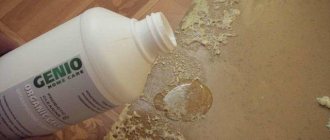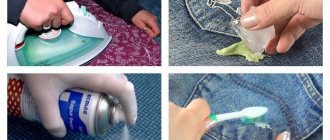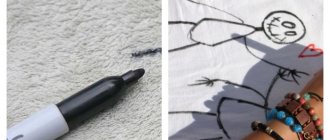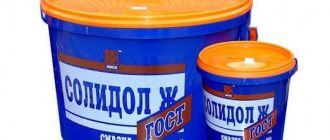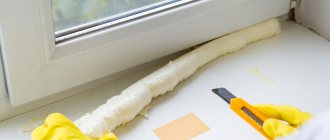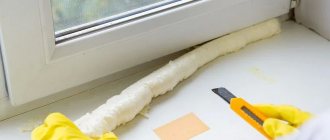Pistol foam TECHNONICOL 50 all-season 650 ml. Photo by Leroy Merlin
Polyurethane foam is used to solve various problems : sealing cracks, waterproofing and other repair and construction work. The demand for foam is promoted by a number of positive characteristics , one of the main ones being high adhesion. In some cases, this property acts as a disadvantage . Since surfaces and fabrics are often difficult to clean from polyurethane sealant.
To remove foam from clothes, various methods, tools and means (special and improvised) are used, which are presented in the article.
General recommendations
Almost everyone who is faced with the problem of how to wash foam from clothes, thinking that it is impossible to do, throws away the damaged item. However, you can get rid of persistent marks if you choose the optimal method for this.
To ensure effective and safe cleaning of the material, consider the following recommendations:
- There is no need to wash the foam and leave the stained item in water for a long time. The water temperature will gradually decrease, which will lead to rapid hardening and hardening of the foam. After this it will be much more difficult to clean it.
- Before cleaning the fabric, pay attention to its type, composition and care instructions indicated on the label.
- When working with solvents, be sure to wear protective gloves and a mask to protect yourself.
- Start working with foam as early as possible, before it hardens. Using a knife, blade or other object, remove excess foam from the surface, moving from its edge to the center, trying not to smear the stain.
What can and cannot be washed from jackets, pants, jeans and other things, shoes
To remove dirt from various items of clothing and shoes, you cannot use some familiar means:
Soudal foam cleaner 0.1 l. Photo by Leroy Merlin
1) Water. They first try to remove any dirt with water. But in this case, doing this is strictly prohibited. Polyurethane foam has a porous structure and absorbs water, thereby penetrating even deeper into the fibers of the fabric. In addition, water helps the mixture harden.
2) High temperatures. Heating leads to a change in the structure of the tissue, but is not sufficient to remove contamination mechanically. When cooling, the components of the composition penetrate even deeper into the fibers of the fabric, which makes it difficult to get rid of dirt.
3) Unrefined gasoline. The composition of the unrefined fuel is not aggressive enough to destroy the polymer bonds of the foam. But stains from using gasoline are almost impossible to remove.
4) Vinegar essence is used to remove stains from various surfaces. However, some experts do not recommend its use, since it is unable to dissolve contamination. In addition, when removing stains from clothes, the essence will ruin the fabric.
5) Hydrogen peroxide solution . Peroxide reacts with foam components, making the composition more viscous. As a result, the mixture adheres even more to the fibers of the fabric.
Removing polyurethane foam using special means
The most effective and logical means of removing construction foam from clothes is special solvents designed for this purpose. They are sold in the same department as the foam itself.
It is recommended to purchase such a product in advance so that, if necessary, you can quickly restore the condition of the tissue.
Valentina Ivanovna
Retired housewife, raising grandchildren
The best cleaners and solvents for polyurethane foam:
| Means | Price | |
| 1 | TRIS | 180 |
| 2 | KUDO | 270 |
| 3 | IRFix | 200 |
| 4 | TechnoNIKOL | 130 |
When working with a still fresh stain, follow the algorithm:
- Remove excess foam using a blunt object with pointed edges.
- Generously soak a cotton pad in the cleaner and apply it to the stained area of the fabric. Leave the cotton pad on the stain for 1-2 minutes.
- Wash the item in water with a large amount of washing powder added.
If the foam has not had time to harden in the fibers of the material, it will be easy to get rid of it. Most often, after the first treatment of the stain with a cotton pad with a cleaner, you will notice that it will disappear.
If the foam has already hardened, it will be somewhat more difficult to get rid of it:
- Use a blade or knife to cut off any excess hardened foam. Do not try to “rip” it out of the fibers, as this will only damage the fabric.
- Apply the special product to the stain and leave the item in this condition for 20 minutes.
- After soaking, scrub the foam mark with a brush or the rough side of a sponge, trying to remove it from the fibers.
- Rinse the fabric and wash it.
Such solvents are designed to clean fabric, so they work quite delicately and do not damage it.
Basic Rules
Before using any of the cleaning methods below, you must ensure that they will not harm your clothing. Most often, work clothes made from thick cotton-based fabrics are stained with foam. Such fabrics are quite resistant, so various solvents can be used on them.
It is much more difficult to cope with the task if the foam gets on delicate materials - fur, suede, silk. Such fabrics require especially careful handling, so it is very difficult to remove foam from them. Thus, exposure of silk or wool to organic solvents can destroy the fibers or discolor the dyes, forming a whitish spot on the fabric. It is better to dry clean clothes made from delicate fabrics.
Mechanical cleaning
When working with coarse and dense material, you can also get rid of traces of polyurethane foam mechanically, the main thing is to work carefully so as not to deform the fabric or spoil it.
Before washing construction foam, use mechanical cleaning. The method of doing it depends on the type of stain:
- If the foam has just splashed onto your clothing and has not had time to harden, remove it from the surface with a blunt object with a pointed edge (such as a ruler or spatula), and then remove it from the fibers using a needle and napkin. After that, just throw the item in the wash.
- If the foam has time to harden, you will have to act in two stages. First, use a blade or knife to cut off the top part of the foam - the “cap”, without touching the fabric itself. After this, use sandpaper or a stiff brush to rub the stained area to remove hardened foam from the fibers. Wash the item and soak it in soapy water for half an hour, and then wash it.
Mechanical cleaning is only suitable for the coarsest fabrics that you cannot damage or deform. In any case, movements with sandpaper or a brush should be gentle and gentle so as not to deform the fibers themselves.
How to Avoid Getting Hit
- to work with polyurethane foam, you must wear clothes that do not have to be washed; if the owner of a house or cottage regularly needs to carry out repair and construction work independently, then it is recommended to purchase work clothes;
- work must be performed using personal protective equipment: glasses, gloves, hat;
- to protect clothes from contamination, a polyethylene cape/cover or cover for clothes, in which the sleeves must first be cut, is suitable; an alternative is a rough apron;
- It is necessary to monitor the condition and location of the cylinder with the nozzle, since cases of uncontrolled foam coming out of a damaged instrument are quite common.
Freezing
Often traces of polyurethane foam can be removed using temperature differences. To do this, you just need to freeze the soiled item. This method is suitable mainly for cleaning fresh or not too hardened foam.
The essence of the method is as follows:
- Roll the item so that the stained area is on the outside.
- Place it in the freezer, being careful not to touch surrounding objects with the uncured foam.
- Leave the material to freeze for 1-2 hours.
- Pull the item out and remove most of the foam with a blunt object with a pointed edge.
- If there is a small amount of foam remaining in the fibers of the fabric, remove it with a nail file or sandpaper. To do this, simply rub the fabric a little, being careful not to deform its structure.
- Wash the item.
Due to the fact that the foam begins to crumble when frozen, you can quickly get rid of most of the stain. Final cleaning of the material can be done mechanically or using folk recipes.
Homemade solvents for removing polyurethane foam from fabric
To avoid using aggressive solvents or subjecting delicate fabric to mechanical cleaning, you can use folk recipes. They are quite safe and often help get rid of even stubborn traces of construction foam and help return the item to its previous condition.
| Method | ||
| 1 | Petrol | More details |
| 2 | Alcohol | More details |
| 3 | Acetone | More details |
1
Petrol
Gasoline is an effective remedy for combating stubborn and old stains from polyurethane foam. It quickly breaks down hardened material and softens it, which allows you to quickly remove unwanted marks from clothing.
However, before you wash the polyurethane foam at home with gasoline, test this method on a small area of fabric.
For cotton, wool and linen items, the method is absolutely safe, but on silk it can leave small stains.
Gasoline should be used as follows:
- Soak a cotton pad generously in gasoline.
- Cut off the foam cap with a knife or blade without touching the fabric, and then apply a damp cotton pad to the cleaned area.
- Leave the stain to soak for 1-1.5 hours.
- Remove the cotton pad and try to wipe off the soaked foam residue.
- Wash the item with added stain remover.
2
Alcohol
Alcohol is a popular household solvent that can be used to clean both light and colored laundry. It is quite gentle on any fabric and allows you to remove both fresh and old foam stains.
Several types of solvent can be used:
- Medical alcohol.
- Ammonia.
- White Spirit.
- Vodka.
Regardless of the type of solvent chosen, the essence of the method is as follows:
- Pour alcohol or vodka into a small container (saucer/cup).
- Place the stained area into the solution.
- Leave the item in this position for 40-60 minutes.
- Rinse the foam mark with water and rub it a little.
- Wash the item.
If you used ammonia to remove the stain, at the last stage wash the item with the addition of aromatic conditioner. It will help reduce the unpleasant smell of ammonia.
3
Acetone
Another solvent that is used for final cleaning of items after freezing or mechanical cleaning. However, acetone can also be used as a separate, complete means of removing dried foam from clothes.
Acetone is a universal remedy because it does not leave marks or streaks on fabrics of any color.
Instructions:
- Apply acetone to the stained area using a brush or cotton pad.
- Leave the stain to soak without rinsing off the product for 10 minutes.
- If possible, remove most of the foam from the fiber structure.
- Re-soak the cotton pad in acetone and apply it to the stained area for 15-20 minutes.
- Scrub the fabric and then wash it with laundry soap.
Attention! You can replace acetone with nail polish remover.
Safety precautions
Before washing off dirt with any toxic means (gasoline, acetone, chemical cleaners), put on thick rubber gloves on your hands. Avoid contact of the substance with the eyes and mucous membranes of the nose and mouth. If the procedure is performed indoors, ensure maximum air circulation by opening the windows.
We recommend reading: How to clean a cashmere coat yourself
To avoid damaging the fabric, the cleaning solution should be tested in an inconspicuous area. The stain will retain its size if you work it from the edges to the center, and not vice versa.
Handy means for cleaning clothes from polyurethane foam
These include dimexide, oil and even the sun.
| Method | ||
| 1 | Dimexide | More details |
| 2 | Oil | More details |
| 3 | Sun | More details |
1
Dimexide
The medicinal solution is used to remove even stubborn traces of polyurethane foam, since its main component is capable of dissolving superglue.
It is recommended to use dimexide only on colored or white underwear, since it may leave stains on light-colored clothes.
Instructions:
- Treat the stained area of material generously with dimexide.
- Leave the item for 10 minutes.
- Use a brush or the rough side of a sponge to scrub the fabric to remove any remaining softened foam.
- Wash the item.
2
Oil
The fats contained in any oil quickly penetrate the foam structure and break it down, which allows you to remove even the most persistent and oldest traces of foam. Oils are often used to remove such contaminants; they have a fairly gentle effect, and they can be used on any fabric.
You can use vegetable oils or cosmetics.
Instructions for use:
- Moisten the stain slightly and apply generous amounts of oil.
- Leave the item to soak in the oil for 10-15 minutes.
- Sprinkle some laundry detergent onto the treated material and rub the fabric to lather the powder.
- Rinse the fabric and evaluate the result. Repeat if necessary.
- Wash the item.
3
Sun
Ultraviolet radiation is the enemy of any construction foam, which is due to the fact that it is based on a sealant, which, when exposed to ultraviolet radiation, begins to crumble and lose its properties. Because of this, among the options for washing polyurethane foam, sunlight is one of the most effective.
The method is suitable for processing absolutely any fabric, regardless of its color and texture, but keep in mind that it will take you several days to complete it. The essence of the method is as follows: place the fabric on the balcony or street so that the stained area receives direct sunlight every day, exposing the polyurethane foam to ultraviolet radiation. By periodically kneading and scrubbing it, you can completely remove the stain.
However, in addition to the duration of the method, it also has another drawback - the risk of fading of the fabric when constantly exposed to sunlight.
Why is it so hard to scrub off?
Polyurethane foam TYTAN LEXY 20 300 ml. Photo by Maxidom
Foam is a polyurethane sealant that contains a significant amount of chemicals: stabilizers, catalysts, thickeners, isomers. As a result, foam is difficult to remove from clothes and shoes (and other surfaces as well) for several reasons:
- Expansion of the mixture. When the composition leaves the aerosol can, the foam begins to actively expand due to the presence of gas in the composition. Once on clothing, the foam continues to expand for some time, simultaneously penetrating the fabric structure. Even low expansion foams are difficult to remove from fabric.
- Fast curing. Quick drying, which takes an average of 15-30 minutes, makes it much more difficult to remove contaminants.
- Tissue damage. Removing the stain is not the only task. It is also necessary to avoid damage to the fabric fibers, deformation of the item, and changes in the color of the clothing. But this is not always possible to achieve. Therefore, you need to know the recommendations that will help you avoid getting foam on your hands and clothes.
